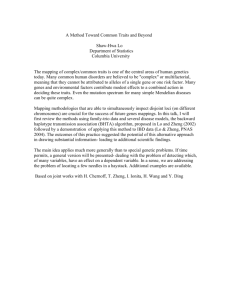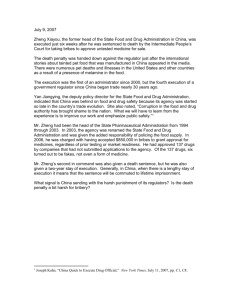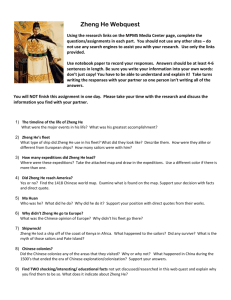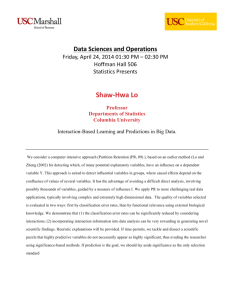Compact and Unforgeable Key Establishment over an ATM Network
advertisement
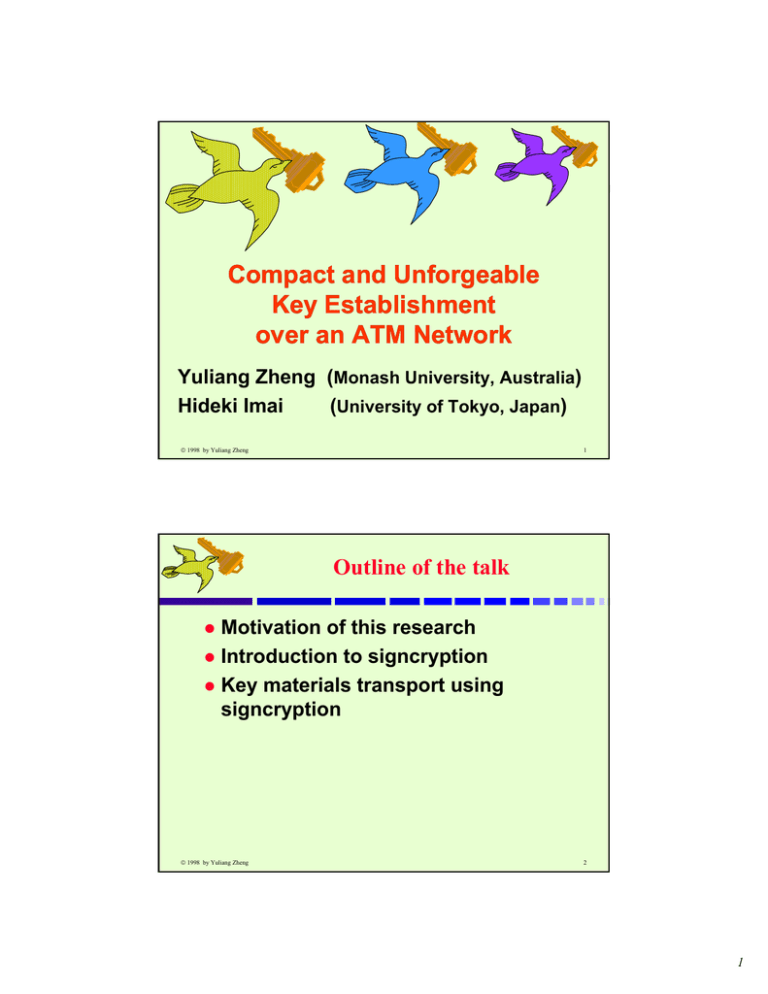
Compact and Unforgeable
Key Establishment
over an ATM Network
Yuliang Zheng (Monash University, Australia)
Hideki Imai
(University of Tokyo, Japan)
© 1998 by Yuliang Zheng
1
Outline of the talk
Motivation of this research
z Introduction to signcryption
z Key materials transport using
signcryption
z
© 1998 by Yuliang Zheng
2
1
Session Key Establishment
A process for two participants to
agree upon a freshly shared key
z Dimensions
z
security against various attacks
authenticity v.s. identification
unforgeability & non-repudiation
transport v.s. exchange
secret v.s. public key crypto
key distrib. center v.s. cert. authority
efficiency (msg length, # of moves, comp cost)
© 1998 by Yuliang Zheng
3
Asynchronous Transfer Mode (ATM)
--- Motivation of this Work --z
Cell switching
Data are placed into cells of fixed-size
(53 bytes), and then
transported over virtual circuits
z
ATM cell structure
5 bytes
header
© 1998 by Yuliang Zheng
48 bytes (384 bits)
payload (data)
4
2
Problem to be solved
z
To transport encrypted key materials
using a single ATM cell
with a low computational cost
in a secure and unforgeable way
without using a KDC
a crypto-envelope
key materials
key, ts or nonce
384-bit ATM
cell payload
© 1998 by Yuliang Zheng
5
Why using a single ATM cell ?
z
If the encrypted version of key
materials exceeds 384 bits, problems
would occur :
splitting data
buffering
re-assembling data
© 1998 by Yuliang Zheng
6
3
Why focusing on public key
cryptosystems
The problem CAN be solved using
using secret key or types of
cryptosystems
z However, with such a solution
z
unforgeability cannot be achieved
without a TTP/tamper-proof devices
Key management is an issue
Distribution
Derivation, and/or
Secure Storage
© 1998 by Yuliang Zheng
7
Why RSA encryption
wouldn’t work
64 bits
Using RSA encryption
k
ke mod n
at least 512 bits
© 1998 by Yuliang Zheng
8
4
Why ElGamal encryption
wouldn’t work
64 bits
Using ElGamal encryption
---DL over GF(p)---
k
gx mod p
k
at least 64+512=576 bits
© 1998 by Yuliang Zheng
9
Why public key “signature +
encryption” wouldn’t work
Using signature + encryption
---RSA or ElGamal ---
64 bits
k
k
sig
ke mod n/ gx mod p
> 512 bits
© 1998 by Yuliang Zheng
10
5
Why EC-signature+encryption
wouldn’t work
64 bits
Using Schnorr sig + ElGamal enc
---DL over Elliptic Curve on GF(2160)---
k
compressed
representation !
k
r, s
x*g
at least 64+(80+160) + (160+1)=465 bits
© 1998 by Yuliang Zheng
11
Signcryption -- a new paradigm
z
Achieves the functions of
digital signature
unforgeability & non-repudiation
encryption
confidentiality
z
has a significantly smaller
comp. & comm. cost
Cost (signcryption)
© 1998 by Yuliang Zheng
<<
Cost (signature)
+
Cost (encryption)
12
6
In the paper & ink world:
Signature-then-Seal
To achieve:
authenticity
(unforgeability &
non-repudiation)
To achieve:
confidentiality
© 1998 by Yuliang Zheng
13
“Magic” Signcryption Envelope
© 1998 by Yuliang Zheng
14
7
In the digital world (Alice to Bob):
Signature-then-Encryption
z
1. Signature generation
Alice signs a
message m using her
secret key, i.e.
creating sig on m.
m
z
2. Encryption
Alice encrypts (m,sig)
using DES with k.
Alice creates another
data so that Bob can
(Typically,
recover k.
Alice encrypts k using Bob’s
public key).
mod exp
mod exp
m
sig
m
sig
k
© 1998 by Yuliang Zheng
15
Why signature-then-encryption
can be a problem
z
Consider a transaction/message of
5,120 bits (=640 chars, ≈ 8 lines)
that requires
high level security, or
to be transmitted in 2010
z
Very large moduli, say of 5120 bits,
have to be used
© 1998 by Yuliang Zheng
16
8
Why signature-then-encryption
can be a problem (cnt’d)
z
If RSA with a 5120-bit composite is
used
Comp. cost:
2+2=4 exponentiations mod a (very large !)
5120-bit integer
Comm. overhead:
10,240 bits (twice as large as the original
10,240 bits
message !)
5,120 bits
5,120 bits
message
sig
5,120 bits
k eb
© 1998 by Yuliang Zheng
17
Why signature-then-encryption
can be a problem (cnt’d)
z
If Schnorr sig & ElGamal enc with a
5120-bit prime are used
Comp. cost:
3+2.17=5.17 (3+3=6) exponentiations
mod a (very large !) 5120-bit integer
Comm. overhead:
>=5,560 bits
>= 5560 bits
5,120 bits
message
© 1998 by Yuliang Zheng
>=440
bits
sig
5,120 bits
gx
18
9
Signcryption -public & secret parameters
z
Public to all
p : a large prime
q : a large prime
factor of p-1
g : 0<g<p & with
order q mod p
hash: 1-way hash
KH: keyed 1-way hash
(E,D) :
z
Alice’s keys
x a : secret key
ya : public key
(note :
ya = g x a mod p
z
)
Bob’s keys
x b : secret key
yb : public key
(note :
private-key encryption &
decryption algorithms
yb = g xb mod p
)
© 1998 by Yuliang Zheng
19
Signcryption -- an example (SCS1)
m
z
(c,r,s)
Signcrypt by Alice
x
k = hash ( y b mod p )
where x ∈R {1,K , q − 1}
k1
k
k2
r = KH k2 ( m )
s=
x
mod q
r + xa
c = Ek1 ( m )
output
© 1998 by Yuliang Zheng
(c,r,s)
(c,r,s)
z
m
Unsigncrypt by Bob
r s⋅ x
k = hash (( y a ⋅ g ) mod p )
b
k
k1
k2
m = Dk (c )
1
output
m
if r = KH k2 ( m )
⎧
⎨" invalid" if r ≠ KH ( m )
k2
⎩
20
10
Signcryption -- another example
m
z
(c,r,s)
(c,r,s)
Signcrypt by Alice
x
k = hash ( y b mod p )
where x ∈R {1,K , q − 1}
k1
k
k2
z
m
Unsigncrypt by Bob
r
k = hash (( g s ⋅ ya ) x mod p )
b
k
k1
k2
r = KH k2 ( m )
m = Dk (c )
1
s = ( x − r ⋅ xa )mod q
output
m
if r = KH k2 ( m )
⎧
⎨" invalid" if r ≠ KH ( m )
k2
⎩
c = Ek1 ( m )
output
(c,r,s)
© 1998 by Yuliang Zheng
21
Signcryption v.s. Signature-thenEncryption
EXP=1+1.17
EXP=2+2
EXP=3+2.17
m
m
m
sig
sig
k
eb
sig
gx
(a) Signcryption (b) Signature-then-Encryption (c) Signature-then-Encryption
based on RSA
based on DL
based on DL
© 1998 by Yuliang Zheng
22
11
Cost of Signature-then-Encryption
v.s. Cost of Signcryption
A simplistic comparison:
Sc he m e s
C ost C om p C ost C om m O ve r he a d
(N o. of e xp )
(b its)
R S A b a se d
sig -the n-e nc
2 +2
|n a | + |n b |
D L b a se d
Sc hnor r sig +
ElG a m a l e nc
3 + 2 .1 7
(3 + 3 )
|ha sh| + |q | + |p |
D L b a se d
Sig nc r yp tion
1 + 1 .1 7
(1 + 2 )
|K H | + |q |
© 1998 by Yuliang Zheng
23
Signcryption v.s.
Schnorr Sig + ElGamal Enc (cnt’d)
|p |
512
768
1024
1536
2048
3072
4096
5120
8192
10240
|q |
144
152
160
176
192
224
256
288
320
320
© 1998 by Yuliang Zheng
|K H |
72
80
80
88
96
112
128
144
160
160
sa vin g in
sa ving in
c o m p c o st c o m m o ve r he a d
58 %
7 0 .3 %
58 %
7 6 .8 %
58 %
8 1 .0 %
58 %
8 5 .3 %
58 %
8 7 .7 %
58 %
9 0 .1 %
58 %
9 1 .0 %
58 %
9 2 .0 %
58 %
9 4 .0 %
58 %
9 6 .0 %
24
12
Signcryption v.s. RSA
|p |= |n a |
=|n b |
512
768
1024
1536
2048
3072
4096
5120
8192
10240
|q |
144
152
160
176
192
224
256
288
320
320
|K H |
72
80
80
88
96
112
128
144
160
160
sa ving in
c om p c ost
0 %
1 4 .2 %
3 2 .3 %
5 0 .3 %
5 9 .4 %
6 8 .4 %
7 2 .9 %
7 5 .6 %
8 3 .1 %
8 6 .5 %
sa ving in
c om m ove r he a d
7 8 .9 %
8 4 .9 %
8 8 .3 %
9 1 .4 %
9 3 .0 %
9 4 .0 %
9 5 .0 %
9 6 .0 %
9 7 .0 %
9 8 .0 %
© 1998 by Yuliang Zheng
25
Applications of Signcryption
z
Bring to society huge savings in
comp. & comm. if used widely in
secure & authenticated message
delivery / storage
electronic commerce
secure & authenticated transactions
secure & authenticated multicast (incl.
video conference, CSCW etc)
fast, compact, secure, unforgeable &
non-repudiated key transport
© 1998 by Yuliang Zheng
26
13
Direct transport of key
materials in a Short Packet
| p| ≥ 512, | q| ≥ 160, | KH ⋅ (⋅)| ≥ 80
( k 1 , k 2 ) = hash( yb x mod p)
c
TQ
r
s
key
with x ∈R [1,K , q − 1]
| k 1 | ≥ 64, | k 2 | ≥ 64
c = E k1 ( key , TQ)
|TQ| + |key| bits
80 bits
160 bits
r = KH k2 ( key , TQ, other )
s=
x
mod q
r + xa
© 1998 by Yuliang Zheng
27
Direct transport of key
materials in a single ATM cell
ATM Cell
5 bytes
header
48 bytes (384 bits)
payload (data)
| p| ≥ 512, | q| ≥ 160, | KH ⋅ (⋅)| ≥ 80
( k 1 , k 2 ) = hash( yb x mod p)
with x ∈R [1,K , q − 1]
| k 1 | ≥ 64, | k 2 | ≥ 64
c = E k1 ( key , TQ)
r = KH k2 ( key , TQ, other )
c
144 bits
© 1998 by Yuliang Zheng
r
s
80 bits
160 bits
s=
x
mod q
r + xa
28
14
Indirect transport of key
materials in a Short Packet
| p| ≥ 512, | q| ≥ 160, | KH ⋅ (⋅)| ≥ 80
( k 1 , k 2 ) = hash( yb x mod p)
c
r
s
TQ
with x ∈R [1,K , q − 1]
| k 1 | ≥ 64, | k 2 | ≥ 64
c = E k1 (TQ)
|TQ| bits 80 bits
160 bits
r = KH k2 (TQ, other )
s=
x
mod q
r + xa
© 1998 by Yuliang Zheng
29
Indirect transport of key
materials in a single ATM cell
ATM Cell
5 bytes
48 bytes (384 bits)
header
payload (data)
| p| ≥ 512, | q| ≥ 160, | KH ⋅ (⋅)| ≥ 80
( k 1 , k 2 ) = hash( yb x mod p)
with x ∈R [1,K , q − 1]
| k 1 | ≥ 64, | k 2 | ≥ 64
c = E k1 (TQ)
r = KH k2 (TQ, other )
c
occupied
© 1998 by Yuliang Zheng
r
s
80 bits
160 bits
s=
x
mod q
r + xa
30
15
2 Dimensions to be considered
z
Direct v.s. Indirect key transport
Direct key material transport
a random session key is explicitly included
in key materials
Indirect key material transport
a random session key is to be derived from
key materials
z
Ensuring Freshness using
a time-stamp, or
a nonce
© 1998 by Yuliang Zheng
31
4 Types of
Key Transport Protocols
Time-varying
Quantity
Nonce
Time stamp
(+nonce)
© 1998 by Yuliang Zheng
nonce based
direct
(3 moves)
nonce based
indirect
(3 moves)
time-stamp based
direct
(2 moves)
time-stamp based
indirect
(2 moves)
direct
indirect
Transport
Mode
32
16
Direct key transport using a
nonce (for unicast)
Alice
Bob
c = E ( key)
k1
r = KH ( key, NC , etc)
k2
b
s = x / (r + xa ) mod q
verify tag
<= NCb <=
Pick a nonce NCb
=> c, r, s =>
unsigncrypt
<= tag <=
(optional)
tag = MACkey(NCb)
© 1998 by Yuliang Zheng
33
Direct key transport using a
time-stamp (for unicast)
Alice
c = E ( key, TS )
k1
r = KH ( key, TS , etc)
k2
s = x / (r + xa ) mod q
verify tag
© 1998 by Yuliang Zheng
Bob
=> c, r, s =>
<= tag <=
(optional)
unsigncrypt, and
check the freshness
of TS
tag = MACkey(TS)
34
17
Indirect key transport using a
time-stamp (2 moves)
Alice
Bob
c = E (TS )
k1
r = KH (TS , etc)
k2
s = x / (r + xa ) mod q
key = KH k1 ,k2 ( TS )
verify tag
=> c, r, s =>
<= tag <=
(optional)
unsigncrypt, and
check the freshness
of TS
key = KH k1 ,k 2 ( TS )
tag = MACkey(TS,1)
© 1998 by Yuliang Zheng
35
How to obtain
key exchange protocols
z
Let Bob’s data or ID be involved in
the derivation of a session key
E.g.
key* = KHkey(NCb)
key* = KHkey (IDb)
key* = KHkey (NCb, IDb)
z
Let both Alice & Bob generate key &
exchange key materials (which
achieves mutual identification).
© 1998 by Yuliang Zheng
36
18
Direct key exchange using a
nonce (for unicast)
Alice
Bob
c = E ( key)
k1
r = KH ( key, NC , etc)
k2
b
s = x / (r + xa ) mod q
<= NCb <=
Pick a nonce NCb
=> c, r, s =>
unsigncrypt
c* = E
unsigncrypt
<= c*, r*, s* <=
( key*)
k *1
( key*, key, etc)
r* = KH
k *2
s* = x * /(r * + x ) mod q
b
© 1998 by Yuliang Zheng
37
ATM Forum Proposals
z
Two protocols, both based on X.509
2-way protocol
3-way protocol
z
Correspondence
ATM 2-way <=> direct key exchange
using a time-stamp
ATM 3-way <=> direct key exchange
using a nonce
© 1998 by Yuliang Zheng
38
19
ATM Forum 2-Way Protocol
(based on sign-then-enc)
Alice
Bob
IDa , IDb , SecOpt ,{Ta , Ra ,{Enc Kb (ConfPara )},
⇒
Sig Ka (hash( IDa , IDb , Ta , Ra , SecOpt ,{ConfPara }))}
IDa , IDb , Ra ,{Enc Ka (ConfParb )},
⇐
Sig Kb (hash( IDa , IDb , Ra ,{ConfParb }))}
⇒
⇐
© 1998 by Yuliang Zheng
39
ATM Forum 3-Way Protocol
(based on sign-then-enc)
Alice
Bob
⇒
⇐
IDa ,{IDb }, Ra , SecNeg a ,{Cert a }
IDa , IDb , SecNegb ,{Cert b },{Ra , Rb ,{Enc Ka (ConfParb )},
Sig Kb (hash( IDa , IDb , Ra , Rb , SecNeg a , SecNegb ,{ConfParb }))}
⇒
© 1998 by Yuliang Zheng
IDa , IDb , Rb ,{Enc Kb ( ConfPara )},
Sig Ka (hash( IDa , IDb , Rb ,{ConfPara }))}
⇒
⇐
⇒
40
20
Advantages of Our Signcryption
based Protocols over ATM Forum’s
z
Significant savings in
computational time and
communication overhead
© 1998 by Yuliang Zheng
41
Comparison with
Beller-Yacobi protocol
Attributes
Comp. Longest Pre
Cost
Msg
comp.
protocols
(# of exp)
BellerYacobi
1 + 2.25
>= 512
bits
Yes
Our
protocols
1 + 1.17 < = 384
(1 + 2)
bits
Yes*
(1 + 4)
* Only when Alice knows whom to communicate with
© 1998 by Yuliang Zheng
42
21
About “Forward Secrecy”
z
Forward secrecy w.r.t. a participant
compromise of the participant’s long
term secret key does NOT result in the
exposure of past session keys
Beller-Yacobi protocol
YES w.r.t. Alice, NO w.r.t. Bob
Our protocols
NO w.r.t. either Alice or Bob
© 1998 by Yuliang Zheng
43
About Forward Secrecy (cnt’d)
z
Forward secrecy w.r.t. Alice CAN be
obtained in our proposals
by making a Alice’s long term secret
key xa hard to compromise
E.g.
secret sharing,
mathematically and/or physically
© 1998 by Yuliang Zheng
44
22
Extensions
z
the proposed protocols can be
extended to “multi-cast” conference
key establishment
Bob
Alice
© 1998 by Yuliang Zheng
Cathy
David
45
Direct multicast key transport using a nonce
Alice & each Ri, I=1,…,t
NC = NC1 + …+ NCt
A lice:
NC1
<= ….. <=
NCt
Each Ri, I=1,…,t
Pick a nonce NCb
key ∈ R {0 ,1} l1 , k ∈ R {0 ,1} l2
h = K H k ( key , N C , etc )
c = E k ( key , h )
for each i = 1, .. , t
v i ∈ R [1, ... , q − 1]
( k i ,1 , k i , 2 ) = hash ( y i v i m od p )
c i = E k i ,1 ( k )
c
c1 , r1 , s1
=> …... =>
c t, r t, s t
Each Ri, I=1,…,t
finds out (c, ci, ri, si)
& unsigncrypt it
tag1
<= …. <=
tagt
(optional)
Each Ri, I=1,…,t
tagi = MACkey(NCi)
ri = K H k i , 2 ( h , etc i )
si =
vi
m od q
ri + x a
Alice & each Ri, I=1,…,t
verify tag1,..,tagt
© 1998 by Yuliang Zheng
46
23
Direct multicast key transport using a time-stamp
A lice:
for each i = 1, .. , t
v i ∈ R [1, ... , q − 1]
( k i ,1 , k i , 2 ) = hash ( y i v i m od p )
key ∈ R {0 ,1} l1 , k ∈ R {0 ,1} l2
get tim e − stam p TS
h = K H k ( key , TS , etc )
c = E k ( key , TS , h )
for each i = 1, .. , t
c
c1 , r1 , s1
=> …… =>
c t, r t, s t
Each Ri, I=1,…,t
finds out (c, ci, ri, si)
& unsigncrypt it
c i = E k i ,1 ( k )
ri = K H k i , 2 ( h , etc i )
si =
vi
m od q
ri + x a
Alice & each Ri, I=1,…,t
verify tag1,..,tagt
© 1998 by Yuliang Zheng
tag1
<= …. <=
tagt
(optional)
Each Ri, I=1,…,t
tagi = MACkey(TS,IDi)
47
Speeding-up through
Randomization
z
Ri may decide, in a probabilistic
fashion
whether or not generating NCi
whether or not multicasting tagi
z
Similarly, Alice and each Ri may
randomly choose a subset of tags
received for verification
© 1998 by Yuliang Zheng
48
24
Summary
addressed the problem of
“unforgeable key establishment in
small packets s.a. ATM cells”
z solved the problem using
signcryption
z Potential applications:
z
high speed networks
smart card based security solutions
mobile communications, ……
© 1998 by Yuliang Zheng
49
25
